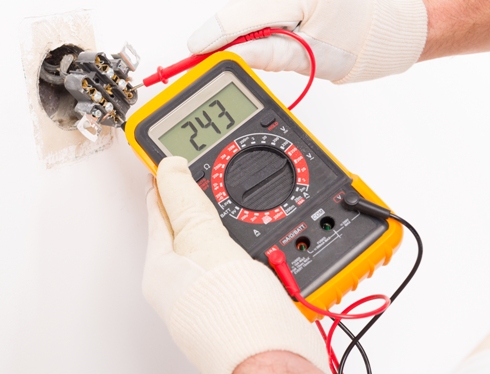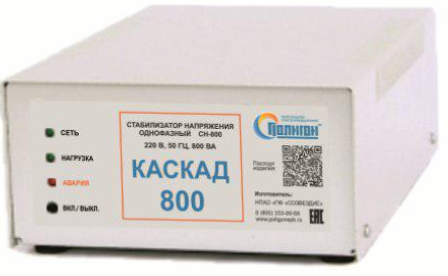Categories: Featured Articles » Electrician at home
Number of views: 12,632
Comments on the article: 1
How to choose a voltage stabilizer for an apartment
A voltage stabilizer is a device connected to a common electrical network and designed to maintain the output voltage within certain limits with significant fluctuations in the input voltage.
When installed at the input of power supply to the apartment, this device, depending on the functionality, normalizes the parameters of the output current, and when deviations go beyond the established framework, it blocks the power supply to all electrical equipment or individual devices.
Do I need a voltage stabilizer for installation in an apartment?
Measurement of the voltage of the mains current at different periods of the day for a sufficiently long time will help to solve this problem. In accordance with the International requirements of IEC 60038: 2009, the values should be in the range 220-240 V. In Russia, the range 198-253 V. is allowed.
In most cases, the quality of energy supply in apartment buildings meets the standards. If, as a result of the measurements, long intervals were revealed during which the voltage was below 198 V or above 253 V, it is recommended to think about purchasing a stabilizer. This is especially true if the apartment has equipment that is sensitive to the quality of the power supply.

What household appliances do you need stabilizing devices for?
Some types of household equipment are initially equipped with systems that allow you to "transfer" quite serious jumps in volt characteristics "painlessly". This technique includes:
-
TVs released after 1985. They are equipped with switching power supplies capable of maintaining a working state in a wide voltage range.
-
Computers Thanks to the integrated voltage converter, they can work with small fluctuations.
-
Active loads. These include irons, hair dryers, curling irons, electric stoves. These devices are able to operate at reduced voltage, but the amount of heat generated by them is reduced.
-
LED lamp. Thanks to the integrated current driver, their brightness is little dependent on the magnitude of the supply voltage.
However, there is a fairly extensive list of equipment that needs high-quality protection against voltage jumps:
-
Vacuum cleaners and air conditioners. The induction motors installed in these devices, when operating under reduced voltage conditions, become very hot, which can cause a malfunction.
-
Old fridges. Under reduced voltage, the engine overheats and buzzes.
-
TVs released before 1985.
-
Incandescent lamps. The brightness of the light is very dependent on the characteristics of the supply current.
-
Microwaves. The lower the voltage, the lower the microwave power. With certain current characteristics, the furnace completely ceases to function.
-
Washing machines. In modern devices, when a critical voltage drop occurs, the program crashes, old models can “burn out”.
-
Dishwashers. With low quality, the power does not turn on.
-
Modern boilers. Very sensitive to variations in current characteristics.

To solve the problem of high-quality power supply for sensitive equipment, it is recommended to install a correctly selected voltage regulator.
The main characteristics of voltage stabilizers
These devices include:
-
Control system of input current parameters. It is designed to cut off the power supply to electrical appliances when the normalizer fails or the current parameters deviate from the allowable range.
-
Integrated Filters. Their task is to suppress impulse noise.
-
Operating and limiting input current systems.The first is for regulating the output voltage. The second - to disconnect devices from power when exceeding the permissible deviations of the current characteristics. The stabilizing device itself remains operational.
-
Short circuit protection.
What are the voltage stabilizers for use in the apartment?
There are several types of stabilizing devices on the market today.
Electronic relay, servo-driven electromechanical
These devices are suitable for solving the question of which voltage regulator is better to choose for servicing electrical appliances in the apartment, thanks to:
-
low noise;
-
speed;
-
lack of need for operator intervention in their work;
-
resistance to temperature changes (can be installed in an unheated room for economic purposes);
-
high resistance to network interference;
-
longevity.
Regulation is stepwise. Instruments can handle high inrush currents. Disadvantages: high cost, little suitable for hams and music fans because of the possible interference, low regulation accuracy.
The most promising direction of modernization of electronic stabilizers is the release of devices with double conversion (inverters). These compact devices provide:
-
high accuracy of output parameters;
-
high performance over a wide range;
-
suppression of impulse noise of mains current.
Due to the significant cost in everyday life, such devices are not yet widely used.
Electronic relay
These are the cheapest devices that provide step control. Their main disadvantage is periodic clicks during operation. However, there are situations in which such devices click almost constantly. The cause of this problem may be:
-
failure of one of the relays, for example burning contacts;
-
very poor condition of the power supply network - a significant number of twists, poor contacts, a small section of conductors with their large length;
-
faulty control system (controller).
Regardless of the cause of the problem, the stabilizing device with constant clicks will quickly fail.
Relay stabilizing devices - the most popular option for home use, thanks to:
-
MTBF and switching speeds that are practically not inferior to electromechanical models;
-
good performance;
-
compact dimensions;
-
lower price compared to servo drives.
Disadvantages: periodic relay failure due to burning contacts, the ability to service only low-power equipment, distortion of the sinusoid of the output voltage, low resistance to power overloads.
Such devices are suitable for ensuring the normal functioning of televisions, refrigerators, lighting, office equipment, ventilation and air conditioning devices.
In the absence of "capricious" electronic equipment and sudden and frequent power surges - this is the best option for a voltage stabilizer for an apartment.
Electromechanical (electrodynamic, servo-driven)
They include: servomotor, autotransformer, control system.
The advantages of such devices:
-
smooth regulation;
-
performance over a wide voltage range;
-
high accuracy of the output;
-
long operational period;
-
ability to withstand short-term overloads.
Disadvantages:
-
carbonization of dust getting inside;
-
sensitivity to low temperatures;
-
the need for periodic replacement of the collector brush;
-
the probability of sparking when closing / opening contacts, which does not allow placing such a device near gas equipment.
In the new models, the wear collector brushes are replaced by durable rollers.However, the price of such devices is much higher than traditional brush devices. Servo-driven models are mainly used in networks without sudden surges.

Power stabilizer selection
When choosing this indicator, the quantity and power of household appliances that will be powered by a stabilizing device are taken into account.
The procedure for calculating the required power:
-
Summarize the rated power of all electrical appliances. These indicators are indicated in the passports or on the cases of devices.
-
Determine the device with the highest starting power. The most common options are an electric meat grinder or air conditioning. The difference between the starting and rated power is calculated and this value is added to the total power calculated in the previous paragraph.
The choice of stabilizer by the number of phases
In apartments, single-phase networks with a voltage of 220 V usually operate, so in this case it is necessary to choose a single-phase stabilizer.
Three-phase devices may be needed for:
-
the presence of three-phase consumers (compressors, boilers, pumps), but in apartments usually there are no such units;
-
connecting the apartment to a three-phase network.
Three-phase stabilizing devices are expensive, so in most cases they are replaced with three single-phase devices.
The choice of stabilizer for accuracy, range, installation location
The range distinguishes between two categories of devices:
-
Working. Determines the possible input voltage range at which the output will give a voltage of 220 V (for a single-phase network) or 380 V (for a three-phase) with an acceptable error.
-
The limit. Determines the magnitude of the deviation of the input voltage from the normal value at which the stabilizer disconnects all the devices it feeds, but it remains operational. Usually it is 14-18%.
The accuracy of the stabilizing device is the maximum permissible deviation of the output voltage from the set value. The higher the accuracy, the more expensive the model. Inexpensive instruments provide accuracy in the range of 2-7%, a deviation not exceeding 1% is a good indicator.
Installation of a stabilizing device usually does not cause difficulties. Most models are designed for self-installation using the brackets present in the package. The only limitation is that the device should be located at least 0.3 m from the ceiling.
There are voltage stabilizers for 220 V networks, which can be put on the shield. However, before purchasing such compact devices, it should be taken into account that they have a low level of mechanical protection and can service electrical equipment whose total power does not exceed 10 kW.
If the choice of a stabilizer for an apartment is difficult, then a rational option is to contact a specialist who will carry out control measurements of the current parameters, determine the frequency and extent of power outages, and analyze the electrical equipment used.
Based on all the data received, a stabilizing device that is optimal for a particular apartment will be selected.
See also at bgv.electricianexp.com
:
